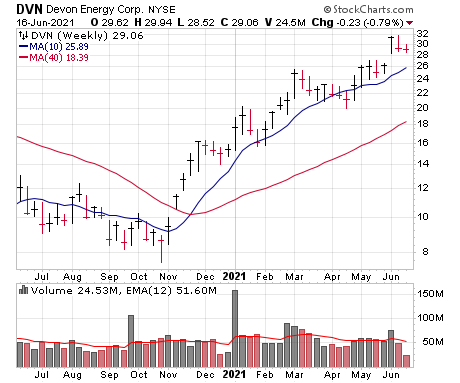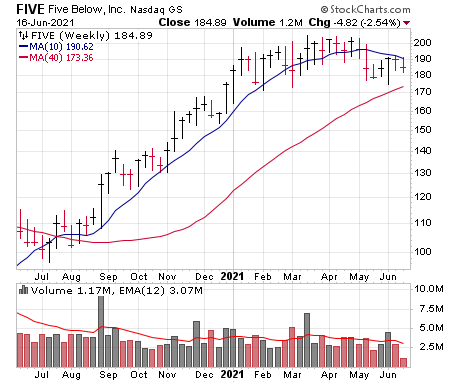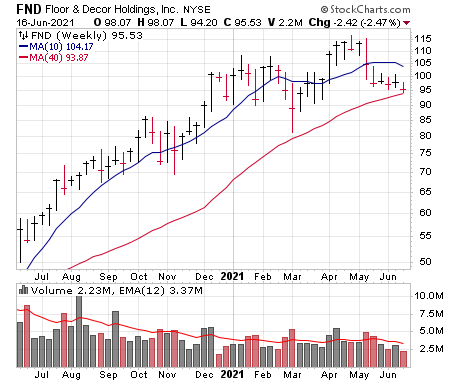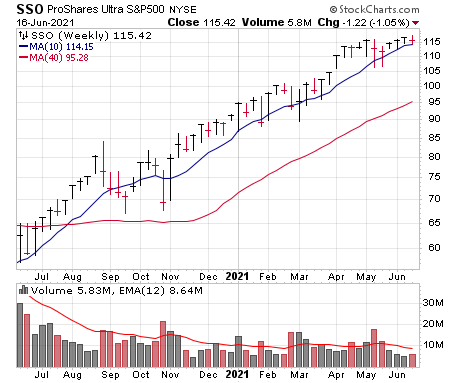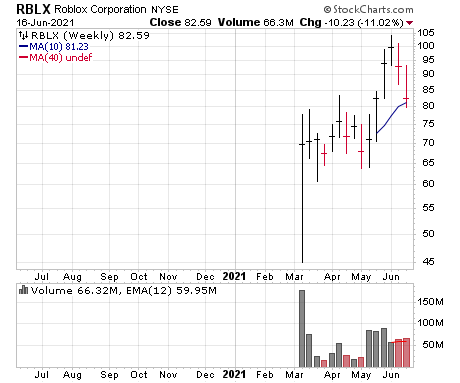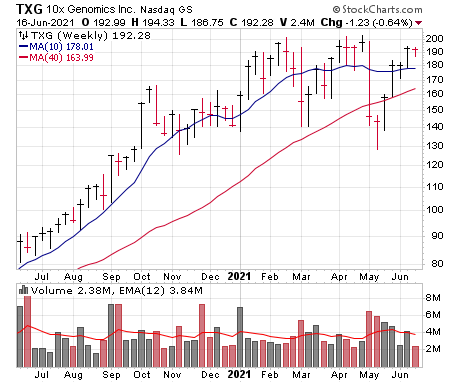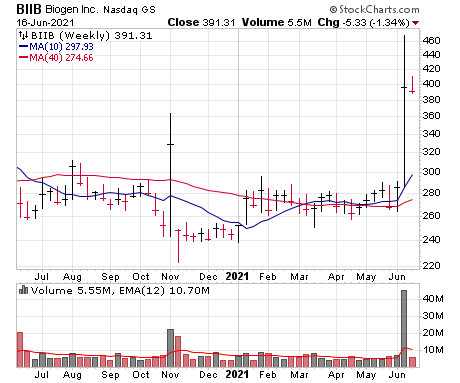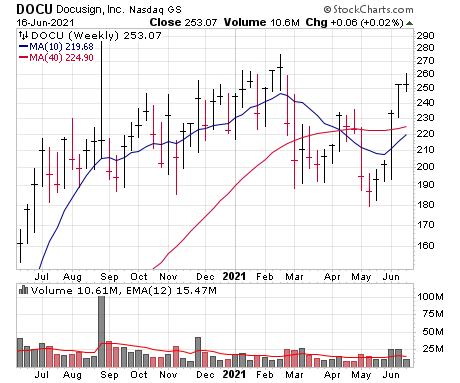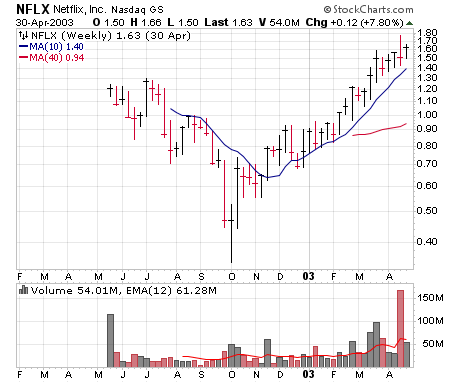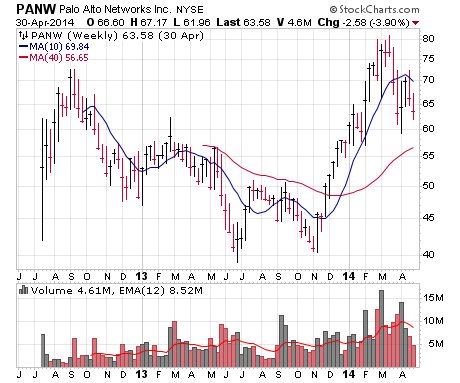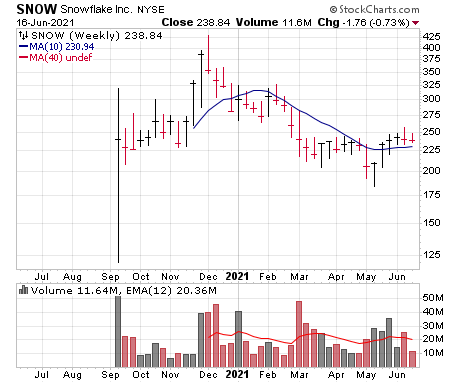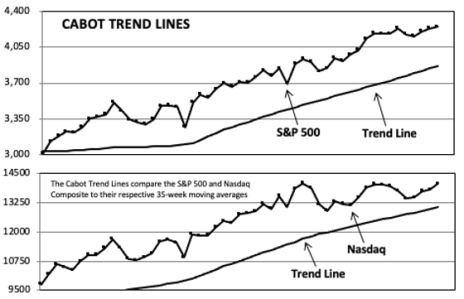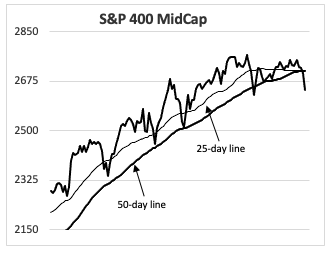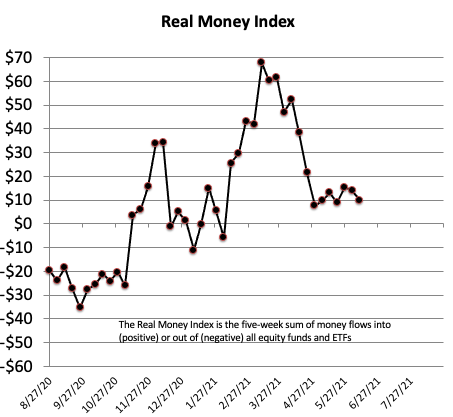Growth stocks continue to slowly repair the damage, with the evidence rounding into form. However, the trick of actually making (and keeping) much money remains very tough — few stocks are showing persistent moves, and those that rally for two to three weeks tend to back off. Maybe that will change—today was certainly a plus for growth stocks — but the point is the environment remains tricky and challenging.
In the Model Portfolio, we’ve been riding things up and down of late, but tonight are holding what we have. There are a couple of names we’re watching that we would like to own, but again, these have ramped up in recent days so we’ll wait for a little shaking and baking. Open up for all of our latest thoughts.
Cabot Growth Investor 1474
[premium_html_toc post_id="232391"]
Still (Mostly) a Meat Grinder
In the last issue we wrote about the baby steps the market had taken since mid-May—it wasn’t anything decisive, but after suffering a ton of damage, growth stocks were slowly improving, with some big-volume rallies, more stocks setting up in multi-month launching pads and an overall smoother, calmer tenor to trading, which is usually a good sign that the buyers are gaining control.
And today, frankly, we still think that’s mostly true—growth-oriented indexes have perked up and held most of their gains, secondary indicators like the number of new lows and our own Aggression Index have done the same, and despite the rally, we haven’t really seen any broad selling pressure emerge for more than a day or two, at least so far.
All of that is good to see, but there’s one key missing ingredient out there: It remains very tough to make money. And the big reason for that is that moves have been fleeting—stocks and sectors that get a head of steam rally for a couple of weeks, but after that most tend to give back a big portion of those gains. Meanwhile, the names that sagged while the others were rallying then catch a bid, and so on. We’ve seen this action in our own stocks and those we’re watching, with breakouts (or potential breakouts) almost universally pulling back 5% to 10%, if not failing outright.
The result is that your timing has to be very precise and you have to be mostly short-term oriented to crank out a profit … and even then you’re talking about pocketing the occasional small-ish morsel, not grabbing a big winner. It’s not quite picking up nickels in front of bulldozers, but it has that same feel—it’s a meat-grinder-type of environment, where what you put in tends to get ground up in no time.
Now, to be fair, a lot of this is far more descriptive than predictive. We wouldn’t say the lack of sustained moves portends doom per se, and a few strong days among individual growth stocks could launch some potentially good-looking breakouts. Today, for example, was a good start, with growth stocks showing some real pep (even as other areas weakened). But we have to see more of this to conclude the market’s character has changed—until then, it’s best to tread carefully.
What To Do Now
Remain patient and relatively cautious while we see if the buying pressures persist. In the Model Portfolio, we’ve been riding the bucking bronco with most of our stocks, but we’re still standing pat with all of them. Our only change since last week is that we’ve placed Roblox (RBLX) on Hold after its sharp pullback this week. Our cash position remains north of 50%. Details inside.
Model Portfolio Update
We’re obviously big fans of market timing, using key indicators and measures to determine the health of the market. But at day’s end, usually the thing you should pay attention to most is the action of the stocks you own and watch—if you’re having a hard time keeping up with the number of stocks popping higher, it’s a good sign.
But, as we wrote previously, when the stocks you own and are watching closely show a lot of one-step-forward, one-step-back action, it’s a sure sign that the underlying environment isn’t conducive to a sustained advance, at least at this point. Roblox was the unfortunate bomb this week, but even beyond that name, few groups and stocks are making any real progress. (That includes many cyclical areas that have begun to crack.)
To be clear, it’s not 2008 out there, and on balance, we continue to think the evidence for growth stocks is improving; we’re not eager to be in some sort of hugely defensive posture and today was an encouraging sign, but unless you’re flipping in and out of things every couple of weeks, making money remains difficult—definitely more of a meat grinder environment.
In the Model Portfolio, we have a few holes in our buckets, but we’re standing pat tonight. As usual, we’re willing to move in either direction from here, but will just take our cues from the market—and, of course, the action of the stocks we own and are watching.
Current Recommendations
| Stock | No. of Shares | Portfolio Weightings | Price Bought | Date Bought | Price on 6/17/21 | Profit | Rating |
| Devon Energy (DVN) | 7240 | 11% | 28 | 5/7/21 | 28 | -2% | Buy |
| Five Below (FIVE) | 852 | 8% | 138 | 9/18/20 | 184 | 34% | Hold |
| Floor & Décor (FND) | 1,004 | 5% | 107 | 4/9/21 | 95 | -11% | Hold |
| Progyny (PGNY) | 1,577 | 5% | 64 | 5/28/21 | 63 | -2% | Buy a Half |
| ProShares Ultra S&P 500 (SSO) | 1,741 | 10% | 60 | 5/29/20 | 115 | 92% | Buy |
| Roblox (RBLX) | 1,052 | 5% | 96 | 5/28/21 | 83 | -13% | Hold |
| CASH | $1,149,328 | 57% |
Devon Energy (DVN)—Typical of what we’re seeing out there, DVN and other energy names have followed up their strong pops seen two weeks ago with selling (especially today) despite oil (holding north of $70) and natural gas ($3.20 or so) prices remaining resilient and generally well above the levels that Devon has cited would result in mountains of cash flow. Also, following along with what an analyst said two weeks ago, any upside in productivity/costs from the wells of WPX Energy (Devon bought them out earlier this year) could also add fuel to the cash flow story—and that wouldn’t be dependent on energy prices per se. Overall, while the pullback picked up steam today, the chart looks OK, with DVN trading well above its 50-day line (now near 25.5 and rising steadily). We’re not complacent, so if the selling really accelerates we’ll make sure things don’t get away from us on the downside, but we continue to think this correction is likely to find support and lead to another rally. Hold on if you own some, and if not, we’re OK grabbing some shares on this dip. BUY
Five Below (FIVE)—Five Below’s growth story is very much intact, as was revealed in the recent quarterly report. We’re encouraged to see earnings estimates kite higher since then, not just for this year ($4.74 per share now expected vs $4.22 before the report) but next year as well ($5.54 vs $5.12), which is important given that some of the Q1 beat came from a lower tax rate—Wall Street is coming around to the view that the company should have higher margins in the post-COVID world as the firm’s spending slows and its digital efforts bear fruit. Even so, the stock remains stuck in the mud; the positive earnings reaction ran into resistance near the 50-day line (not abnormal) and has backed off, but net-net, not much has changed with the chart. The sector has become a bit of a worry (many “turnaround” retailers have stalled out, which could present some near-term uncertainty), but all told, the odds continue to favor the next big move being up as the best-in-class growth story plays out. Back to the chart, a plunge below longer-term moving averages (lower 170s) would certainly be a red flag, but right here we advise continued patience as we wait for the overall uptrend to resume. HOLD
Floor & Décor (FND)—As mentioned above, many cyclical stocks have cracked their uptrends lately, and some of the worst performance has come from housing-related issues, with key homebuilders and housing supply stocks breaking down. Thankfully, FND hasn’t seen the same slippage, but of course shares had already hit a pothole before that. All told, if this correction is going to give way to a fresh advance, support should show up around here—we don’t view the tedious correction and consolidation (20% from top to bottom) as longer-term abnormal, and indeed, FND is still above its 200-day line (92.5 and rising). Right here, we’ll continue to grit our teeth; if the buyers can return, we still believe the larger uptrend can resume, but there’s not much wiggle room left before we’ll cut bait on our half-sized position. HOLD
Progyny (PGNY)—You don’t hear much about Progyny when reading about the market or leading stocks, but that’s fine by us, with this unique growth story likely to attract more and more big fish (290 funds owned shares at the end of March, up from 183 six months prior) in the quarters ahead. While management has proven deft at sales and onboarding (it welcomed 44 new clients at the start of this year, bumping the overall client base by 33%), the underlying story here is powerful because the company’s fertility offerings (including access to clinics and specialists) work much better than standard care: The latest data (released in Q1) shows that Progyny’s pregnancy rate is 16% above the national average, while its miscarriage rate is 26% lower than average, which means much happier customers and financial savings for clients that have to fund fewer IVF treatments. Moreover, other key metrics (multiples birth rate is 72% better than the national average, resulting in far fewer high-risk pregnancies) are also impressive. Of course, the valuation here shows that investors are expecting big things, but barring a big misstep, there shouldn’t be much standing in the way of rapid growth as more and more (often big) firms sign on in an effort to boost their benefits and save money on fertility services. PGNY continues to act well; we’re OK starting a position here, but we’ll wait to buy more until the stock can get up and moving. BUY A HALF
ProShares Ultra S&P 500 Fund (SSO)—We admit that we’re growing a bit skeptical of the S&P 500 in the near term—the index (and SSO) has definitely lost momentum since mid-April, with the latest new high showing little in the way of power. And today, the index pulled in right near its 50-day line, which it’s generally respected over the past few months. Plus, it’s hard not to notice some of the cracks in the formerly strong cyclical areas (take a look at big, liquid names like FCX, CAT and DE, not to mention XLF), which was one of the big drivers of the S&P in recent months. Thus, it’s fair to say our antennae are up, at least in the short and intermediate term—a decisive crack into the upper 100s would probably coincide with a Cabot Tides sell signal, which would at least have us switching to Hold if not trimming our position after such a big run. That said, you could have thrown a bunch of darts at this rally in recent months, but the sellers have been unable to really make headway and SSO remains within spitting distance of all-time highs. All in all, our antennae are up, but we’ll follow the plan: If you own some, hang on, though if you’re not yet in we suggest starting with a smaller-than-normal position and keeping your eyes open in case we do see a real change in character. BUY
Roblox (RBLX)—Roblox had been pulling back sharply but normally for a few days; despite that action, the overall chart (including three huge-volume up weeks), story and numbers all pointed to good things. But in this environment, nothing is certain, and the company’s business update for May (released Tuesday evening) caused some abnormal reaction—bookings per user actually slipped from a year ago, while overall users were down from the prior month. On a positive note, Roblox said revenues were likely up 125% from May 2020, but on the whole, the May update was pretty much the polar opposite of the bullish April figures (released with the Q1 report a month ago), altering perception (at least for a time) that Roblox’s offering will continue to grow nicely even as the pandemic vanishes. Long term, we still think the firm’s unique platform has a ton of applications that will drive growth, but the near term is obviously less certain. More important, the stock’s dive on Wednesday brought it back to its breakout level—seeing the entire breakout and subsequent follow-through completely evaporate is not the type of action a new leader typically displays. On the plus side, the stock has so far held support in the 79 to 80 area (that’s generally our mental stop at this point), so we can’t say all hope is lost, but as we wrote in yesterday’s bulletin, if the recent dip was just a shakeout, RBLX should start recovering from here. We’ve switched our half position to a Hold rating and are watching it closely. HOLD
Watch List
- 10x Genomics (TXG 199): 10x Genomics has a great big-picture story, and what’s caught our eye is the stock’s abnormal (in a good way) recovery from its earnings implosion a few weeks back. See more below.
- Align Technology (ALGN 613): ALGN continues to see its ups and downs become less dramatic and it’s within a few percent of its old highs.
- CrowdStrike (CRWD 241): Like most growth stocks, it still has work to do, but CRWD continues to eat into overhead resistance and there’s little doubt its best-in-class cybersecurity platform will see strong, growing demand for a long time to come.
- DocuSign (DOCU 261): DOCU is another name that’s come back to life, this time thanks to a very strong Q1 report. The story is as good as ever, and this strength comes after a 10-month rest. See more below.
- Dynatrace (DT 56): DT has returned to resistance levels (56 to 57 area) and, once again, it’s hit some resistance—but if it can break through in the days ahead, it could finally kick off an advance it’s been prepping for since last summer. Fundamentally, there’s little doubt growth will be rapid and reliable for a long time to come.
Other Stocks of Interest
10x Genomics (TXG 199)—10x Genomics has been one of our favorite fundamental stories for many months, partially because it has the look and feel of the next Illumina: The firm’s products and platforms have become the gold standard for biological and cellular/gene analysis and, thus, are being gobbled up by research outfits and enterprises. The biggest draw is Chromium, which allows for analysis on a single cell level; there are north of 2,000 installed, each generally bringing in an average of $150,000 of recurring income (assays, etc.) a year. Visium is a spatial gene expression offering, allowing clients to map all mRNA molecules within the context of a tissue, while the In Situ platform (still in development) could be big in the clinical setting. The details can give you an ice cream headache if you’re not a biologist, but suffice it to say that 10x looks like it’s becoming the new toolkit for biological research, which is a giant market—there’s north of 15,000 next-generation gene sequencing systems out there (about six times 10x’s current installed base), and management says it believes its potential market is far larger than just that chunk of machines. Thus, along with the recurring revenue aspect, the potential here is enormous, especially as the firm continually comes out with new assays and kits that boost the usability of its offerings. The stock had a big run last year, and looked done for when it collapsed in May after earnings. But we’re always on the lookout for unusual action, and TXG’s recovery has certainly been unusual—after diving to multi-month lows, the stock flashed three straight big-volume support or accumulation weeks, and shares are now testing all-time highs. Like most everything, TXG isn’t out of the woods yet, but the persistent rally certainly makes it seem like the earnings move was one big, market-induced shakeout. 10x is back on our watch list.
Biogen (BIIB 384)—When you get down to it, so much of making money in stocks comes down to looking for changes in character—sometimes that action can be subtle, but other times it can be more dramatic, similar to a boulder being dropped into a lake, creating ripples that spread for a while. That latter may be what’s happening with Biogen, the big, old biotech outfit that’s long done great business thanks mostly to its multiple sclerosis franchise, but the stock has been stuck in the mud for years (the peak was in 2015). However, last week brought what could be a game-changer—the FDA approved Biogen’s treatment for Alzheimer’s, dubbed Aduhelm, which is the first to actually target the underlying physiology of the disease; after 18 months of treatment, the amount of amyloid beta plaques in the brain decreased 60%-plus in trials, which should result in a slowing of the disease. That said, the approval has been controversial to say the least—some FDA members have resigned after the decision (the drug was thought of as a dud less than a year ago before new data came in; some doubt it will work much at all), Biogen’s decision to price it aggressively ($56,000!) is already catching the ire of some doctors (and politicians) and there will likely be competition starting in 2024 from other Alzheimer’s drugs that are in trials. Even so, shipments are starting soon and most of Wall Street sees huge things ahead—many analysts see peak sales in the $15 to $40 billion range (!), though to be fair, earnings estimates for this year and next remain mundane. It’s certainly a special situation with a lot of uncertainty, but while everyone argues about what comes next, BIIB has turned strong: News of the approval resulted in a ridiculous upmove, and so far, the stock has refused to give much of it back. The longer it can hold the big approval move, the greater the chance BIIB is leaving behind its six-year consolidation.
DocuSign (DOCU 261)—From its original September 2019 breakout to its top last September, DocuSign was a great winner for us, and now we’re taking another serious look at the stock as it’s come back to life after what’s been a 10-month rest. The story here was always the main attraction, and it’s as good as ever: DocuSign is the hands-down leader in the eSignature business, helping firms automate the gargantuan number of contracts that they ink every day, saving tons of time and money. That alone is a $25 billion market, but the company has its eyes set on even larger prey—DocuSign’s so-called Agreement Cloud attacks its own $25 billion opportunity by offering things like document preparation, remote notarization and contract management. Fears that this is just a “pandemic stock” don’t hold up, as the firm’s products save time and money in any economic environment. And the numbers bear that out, as revenue growth continues to accelerate (up 58% in Q1), earnings are going through the roof (estimated to rise 81% this year and another 30% in 2022) and sub-metrics (customers up 50% from a year ago, same-customer revenue growth of 25%) are surging. Thus, growth is rapid and reliable, and the third R (long runway of growth) is here as well—management believes it’s penetrated “much less than” 10% of its target market, so it’s really just a matter of continuing to execute. As mentioned above, the stock had a monster run but topped last September on a wild post-earnings rally failure; as of a few weeks ago, the stock was living below longer-term moving averages and looked left for dead. But it’s now seen two straight big-volume up weeks as the stock has approached its closing highs. In this market environment, buying after this move isn’t likely to work well, but a breather for a bit or some tightness could be tempting.
Volume Clusters After IPO Droops Can Often Mark the Turn
One of the trickiest things about IPOs is that many (especially high-profile ones) will endure what we call the “IPO droop” for a few weeks or months after coming public. That’s why we rarely advise going after IPOs during the first two or three weeks after they come out—without some chart action, it’s impossible to really know what the Fidelity’s and T. Rowe Price’s of the world think of the stock.
Sometimes this droop lasts a couple of months and other times it can last years, it just depends on the stock and market environment. What’s interesting is that, unlike more established stocks, sometimes it takes just two or three weeks to turn the corner—we’re still studying it, but there are some major examples where two or three volume clusters (two or three weeks in a row of big buying volume) have served to turn the tide on what turned out to be huge winners.
The initial example was Netflix (NFLX), back when it was growing fast as a DVD-by-mail outfit and putting firms like Blockbuster out of business. It came public May 2002, in the midst of the horrid bear market, and proceeded to plunge into the market’s October low. While it’s hard to see on the chart, the two weeks at the start of October brought gigantic upmoves in both price (nearly doubled!) and volume (by far the two largest volume weeks since the IPO). That was pretty much it for the downturn, with the stock enjoying a 10-fold move higher to its peak in 2004 (not shown).
Moving ahead a decade, we have Palo Alto Networks (PANW), which back then was the new-age cybersecurity provider of its day. After the mid-2012 IPO got off to a good start, the name fizzled for more than a year. But in November 2013, something changed—the stock flashed four straight big-volume buying weeks right off the low, kicking off not just a good intermediate-term run (went from 55 to 80 in just a few weeks) but after a correction, a huge longer-term upmove, too (to 200 in mid-2015).
Most recently, look at Shopify (SHOP), which has been one of the largest winners of recent years. The IPO in mid-2015 led to some wild swings before it was cut in half by early 2016. But similar to PANW, Shopify then had four straight above-average volume buying weeks right off the low (three came on very big volume), which was the start of what turned into a ridiculous advance.
Why write about this now? Because of one name that’s caught our eye: Snowflake (SNOW), which seems to be completely upending the data management space—the firm’s data cloud platform doesn’t just allow firms big and small seamless access to and the power to mine their data, but also offers the ability for safe data sharing inside and outside an organization (setting up powerful network effects). Just about all data types are allowed, there’s no compute limitations, it’s all in a single programming language and—importantly—Snowflake charges based on consumption (not subscription), which (a) makes it cheap enough for small fries and (b) leverages it to greater data usage and sharing among its clients. Analysts think it’s playing in a $75 billion market.
The numbers are impressive to say the least: Revenues have been growing at triple-digit rates for many quarters (up 110% in Q1), and perhaps more eye opening is the firm’s remaining performance obligations (RPOs—basically all money under contract that it’s set to earn going forward). At the end of Q1, it had $1.43 billion of RPOs, more than triple that of the year before. Moreover, while earnings are negative, free cash flow was in the black in Q1.
The bugaboo since SNOW’s IPO last September has been valuation. It’s massive! Even today, sitting well off its prior high, the market cap is north of $70 billion! However, this is clearly a unique growth story that big investors are favoring (852 funds own shares already), and it might be following the pattern of the above-mentioned winners—after being more than cut in half from its peak and hitting lifetime lows in May, SNOW saw a three-week volume cluster, which included very nice supporting action after earnings.
Of course, just looking at the chart, it’s hard to conclude it’s completely out of the woods—there’s plenty of overhead to chew through, including a decent amount just above here. But it does look like SNOW has changed character, and the volume cluster has us intrigued. Officially we want to see more strength, but if you wanted to start with a token position here, we wouldn’t argue with it. WATCH
Cabot Market Timing Indicators
Growth stocks continue to improve, but for the overall market, we’re actually seeing some iffy action: The major trend is up, but the intermediate-term trend is back on the fence and there’s no question many cyclical leaders are cracking. It’s another reason to go slow.
Cabot Trend Lines: Bullish
Our Cabot Trend Lines can be a bit of a broken record, but that’s part of the attractiveness, as they keep us in gear with the market’s larger, longer-term trend. The major indexes have lost some steam of late, but that hasn’t come close to denting the overall bull market—at the close of last week, the S&P 500 (by nearly 10%) and Nasdaq (by nearly 8%) stood well above their respective 35-week moving averages. The odds continue to favor higher prices in the months ahead.
Cabot Tides: On The Fence
Our Cabot Tides are back on the fence after today, with many indexes we track hovering near their 50-day lines, while some (including the S&P 400 MidCap) slicing below its 50-day line. The market has had many stick saves in recent months, so we’re not ruling anything out, but if all is well we’d expect the buyers to show up relatively soon.
Cabot Real Money Index: Neutral
Our Real Money Index remains in neutral territory, with not much money flowing into or out of equity funds during the past few weeks, net-net. To be fair, there are a growing number of signs of complacency (surveys, etc.), but when it comes to money flows (usually more reliable), we’re not seeing much convincing evidence in either direction.
Charts courtesy of StockCharts.com
The next Cabot Growth Investor issue will be published on July 1, 2021.
Cabot Wealth Network
Publishing independent investment advice since 1970.
President & CEO: Ed Coburn
Chief Investment Strategist: Timothy Lutts
Cabot Heritage Corporation, doing business as Cabot Wealth Network
176 North Street, PO Box 2049, Salem, MA 01970 USA
800-326-8826 | support@cabotwealth.com | CabotWealth.com
Copyright © 2021. All rights reserved. Copying or electronic transmission of this information without permission is a violation of copyright law. For the protection of our subscribers, copyright violations will result in immediate termination of all subscriptions without refund. Disclosures: Cabot Wealth Network exists to serve you, our readers. We derive 100% of our revenue, or close to it, from selling subscriptions to our publications. Neither Cabot Wealth Network nor our employees are compensated in any way by the companies whose stocks we recommend or providers of associated financial services. Employees of Cabot Wealth Network may own some of the stocks recommended by our advisory services. Disclaimer: Sources of information are believed to be reliable but they are not guaranteed to be complete or error-free. Recommendations, opinions or suggestions are given with the understanding that subscribers acting on information assume all risks involved. Buy/Sell Recommendations: are made in regular issues, updates, or alerts by email and on the private subscriber website.
Subscribers agree to adhere to all terms and conditions which can be found on CabotWealth.com and are subject to change. Violations will result in termination of all subscriptions without refund in addition to any civil and criminal penalties available under the law.

